Everybody is talking about high-quality content but what does it even mean these days? That’s what we are going to find out today. There’s no content marketing inception. The truth is that high-quality content is contextual and for maximum results, it requires three steps: keyword research, good content writing, and on-page search engine optimization.
Let’s find out how to perform top-notch keyword research, how to measure results and optimize pages up front for astonishing on-page SEO, respecting Google’s quality guidelines. It might sound sophisticated but as long as you write unique content, provide valuable content to the user compared to other pages, offer insightful analysis, Google will reward you.
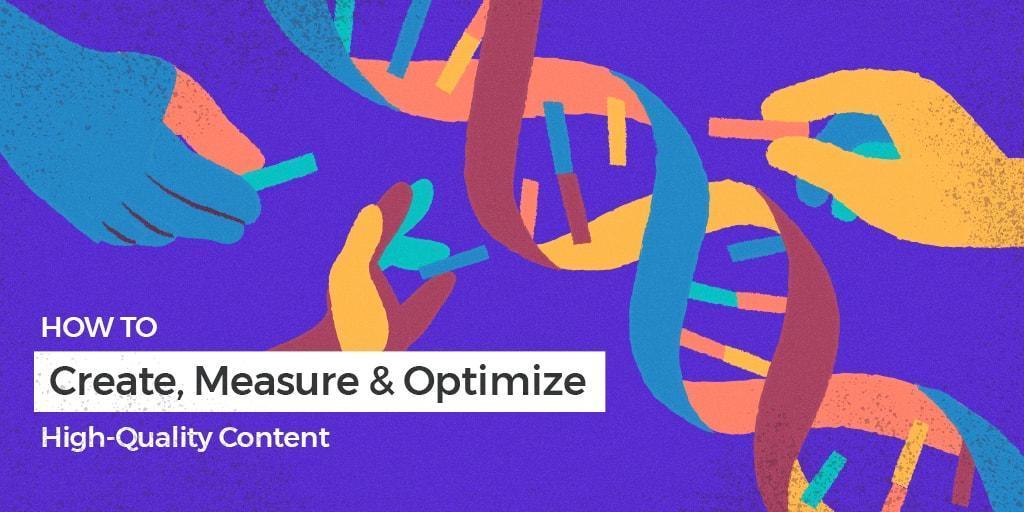
We have to admit that there is a noisy environment due to the high amount of content on the web. So let’s try to shed some light within the “high-quality content”; what does it mean, how to create it and how to measure it.
- What is High-Quality Content
- How to Create High-Quality Content
- How to Optimize Your Content Following the Google-Approved Way
- Three Methods to Measure High-Quality Content
I have a saying that I go by in the whole process of creating high-quality content: don’t be a dwarf against giants, but rather the peak they are trying to reach.
1. What is High-Quality Content
Google explains very well what is high-quality content and how you can achieve it:
| If your pages contain useful information, their content will attract many visitors and entice webmasters to link to your site. In creating a helpful, information-rich site, write pages that clearly and accurately describe your topic. | |
Google Panda algorithm was designed to distinguish and reward the high-quality content from all the worthless one. In order to have good results, content should first answer some questions regarding its quality, such as:
- Would you trust the information presented in this article?
- Does the site have duplicate, overlapping, or redundant articles on the same or similar topics with slightly different keyword variations?
- Are the topics driven by genuine interests of readers of the site, or does the site generate content by attempting to guess what might rank well in search engines?
- Does the article provide original content or information, original reporting, original research, or original analysis?
- Does this article have spelling, stylistic, or factual errors?
- Does this article provide a complete or comprehensive description of the topic?
- Does this article contain insightful analysis or interesting information that is beyond obvious?
You can find lots of other questions you should ask yourself on Google Webmaster Central Blog.
After all the algorithm updates that passed by us, being witness to tons of (sometimes useless) content written every day, we got to the point where we can easily spot the quality of the ordinary in the web. As you can see, everybody is talking about quality and not quantity, but few of them really know what makes a piece of content qualitative.
If you’re starting to use the quality content terminology for everything that you think “it is a great idea”, then you might not distinguish the good from the bad.
Quality content is defined by success. It is defined by a goal and it must bring good metrics/results.
Performance is what really matters. Avoid tricks intended to improve your search rankings and “get you on the first page in one week”.
It does matter how much time you spend creating the content or if you think it might be a good idea. You must understand that your audience has the final say.
Your content must be lovable.
That’s right. You must attract the audience. Context is a great help for getting lovable content. We can define quality content by that type of content that fulfills the needs of the user. Especially now, when personalized content is on the rise and native advertising is a content marketing trend.
But what exactly does context mean?
Google developed patents for discovering the contextual content through topical searches to offer valuable information and increase the user experience. Actually, through context Google wants to recognize the user intent.
If you want to have contextual content you must think very well at your topic and point out all the answers.
If you’re searching for “Batman” in October, most likely you’ll be shown websites selling Halloween costumes. If you’re searching for “Batman” while you are in Turkey, you will probably be redirected to info related to the city of Batman.
Contextual content relates to the location as well. You have to know your niche very well in order to provide value through your content and appeal to them.
Your audience gives value to your content.
You’ve heard it before: if your audience loves the content, Google will definitely love it too. No more shenanigans, no more shortcuts or shitty content. Talk from your heart, in your own words, from your experience. And give wisdom and pieces of advice.
Lots of SEO specialists say that the era of “content is king” has ended, and made room for the saying “context is king”.
Evergreen content can be an example of quality content. Is that type of content that will always be “available”, accurate. It will teach your audience. It passes the test of time, being relevant at every hour of the day. It won’t bring you spikes in traffic, it will sustain it.
Imagine if you can offer a quality answer to a question that is timeless. You’ll be sitting on a gold mine. Original content is considered to have quality. Zach Bulygo agrees.
| Original also means originality. Your ideas should be original! Rehashing the same concepts or other posts over and over again is not original. If your content is played out, no one will link to it – and that defeats the purpose of writing content in the first place. | |
| Zach Bulygo | |
| Content writer at Kissmetrics / @zachcb1 | |
2. How to Create High-Quality Content
Quality content doesn’t come very often and it is not something you can achieve fast. Nobody can predict with accuracy if your articles will be successful, but there are some things you could do to influence the outcome.
Step 1: Monitor Topics
You could find yourself in one of these two situations: either you have already written some articles or you are starting fresh. In case you are finding yourself in the first situation, you have the advantage of testing the market and having a clue about your audience. In case you are on the second situation, then it’s our time to shine, see what your competitors are doing, know your product, and start to write content, test and write again until you find what is working for you.
If you are already on the “content market”, first you need to check the data of your previously published articles to see which articles worked best (with high numbers in traffic and higher rankings).
Larry Kim explains it better:
| You need the quantity to find the quality. | |
| Larry Kim | |
| Founder of WordStream | |
Step 2: Perform Keyword Research
Once you know what topic works for you, you can search for keywords and try to find out the lexical field to know all the terminology. Keyword research is mandatory in this phase. There are lots of tools that can easily do the job for you. Keyword Tool is an example that is very easy and fast to use. In a quick search, it reveals thousands of related topics & keywords opportunities.
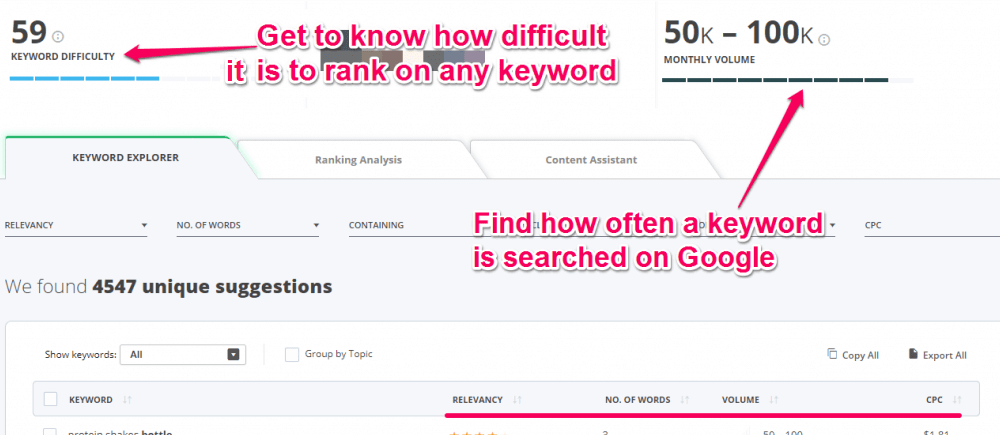
There are some things you should know once you get here. Look at the volume and keyword difficulty. Look for keywords with high search volume. If the difficulty score is around 50, that means the competition for that keyword is medium.
In the screenshot above you can see what search results for “protein shakes”. You can find new topic ideas, search for specific keywords depending on which user intent you are tracking.

You search for questions in case the user wants to learn how to do something (for “how-tos” articles); for focus keywords in case you want to cover a more comprehensive blog post; phrase match for specific situations and so on.
Keyword research will never be out of style. It will always be in trend. It’s a must. But another must is knowing to be selective and wise.
Keyword Tool can work very well with other tricks I am following myself. Google is a bundle of information. You can search for the specific query in the search bar and see what other people are searching for with the autocomplete feature.

Since Google becomes more contextual, it is best if you try and use this practice. Results might differ from one location to another. Also, on Google’s bottom of the page, you can see searches related to your query.
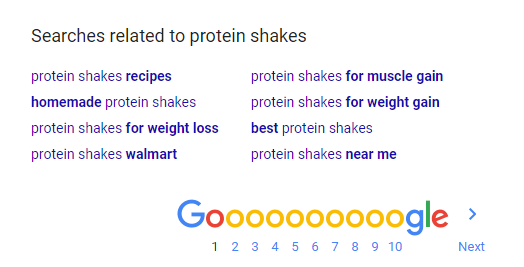
Performing these quick searches might help you get a better understanding of what do people are looking for, and also what type of information you can find on the first page. Do you differentiate yourself from the competition? Are you providing added value? Will your piece of content be unique? If your answer is yes to all thse questions, then you’re on the right track.
There are also free tools that can strengthen your keyword research:
- Google Adwords (there is a free option);
- Kparser;
- KWFinder;
- Answer The Public.
Step 3: Gather Keyword Data From Previous Paid Search Campaigns (optional)
Google Adwords offers historical information of your data you can use for driving SEO traffic. For example, you can see the time frame when your campaigns are performing best, which keywords work best, and how much traffic you’re bringing to your website, and you can optimize those metrics.

You can receive information for monthly searches and see exactly which month has more or lower searches. That is influenced if you are searching for a query for seasonal content. The available data for the free account are average monthly searches, competition level, lowest and highest bid.
When you finished with the keyword research, you should focus your attention on the competition. We mentioned it before and it is a step you shouldn’t skip. Look at the first 10 positions in Google or Bing to see what topics were debated, what is already written, what’s missing with the purpose of highlighting your added value.
Step 4: Spy on Your Competitors
In terms of content, there are a lot of things to take into consideration and that’s why tools have high benefits in the content creation process. For example, Keyword Tool will show a list of all the pages with some extra information that is hard to collect by hand.
In the screenshot bellow, it is highlighted the data gathered for each page:
- (1) the content score, which is calculated based on the keyword pattern form all the pages that rank for the specific search queries.
- (2) the number of focus keywords used out of the total of keywords used to calculate the content score.
- (3) the readability score calculated using the Flesch – Kincaid readability scale which indicates how complicated a piece of text is to understand.
- (4) the number of keywords on the page.
- (5) the list of keywords used to calculate the Content Performance score for that particular web page.
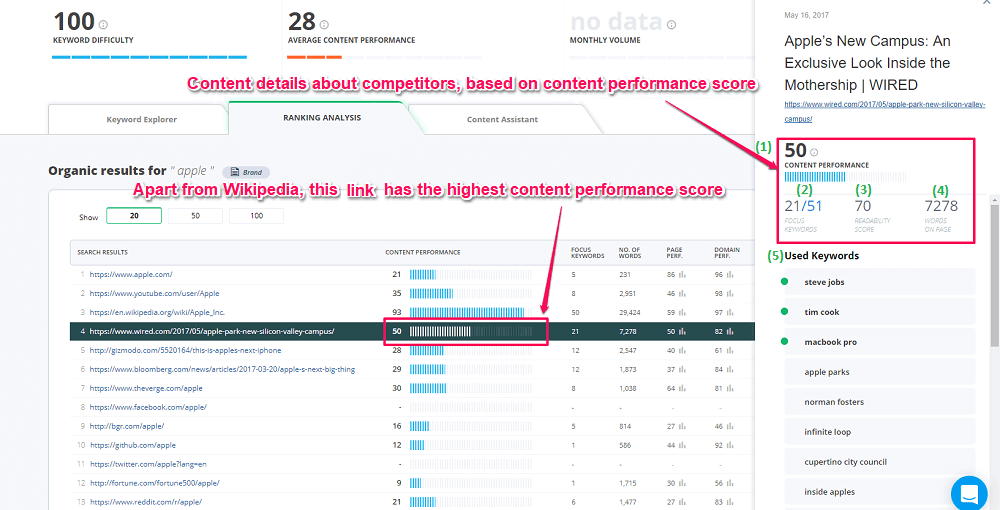
Having an idea of your competition is a good insight for you to cover-up what’s missing and improve search engine content discovery offering the best piece of content. With such a rich handful of data, you’re prepared to go to the next step: optimization.
3. How to Optimize Your Content Following the Google-Approved Way
If we are talking about optimization you must understand that natural language paired with traditional on-site SEO techniques are the key to success. Highly readable pages are the winner in the whole content-discovery adventure.
Step 1: Make a Content Plan
Google is evaluating multiples factors using various quality signals to see if your content is relevant to a specific query. At this point, there is nothing tricky, just a lot of math and natural language processing. To save time and effort, Content Assistant will help you identify the exact keywords your content is missing to rank higher.

The mechanism is simple and fast:
- paste all the content in the Content Assistant to start analyzing it;
- add keyword suggestion to increase your content performance score;
- rewrite the underperforming content and add new content, if needed, to make the keywords inclusion more logical and natural.
Of course, the content performance score is not the only factor that matters when Google ranks a webpage but, it can give you an idea of the position you can achieve. Link metrics are important as well.
Step 2: Follow Successful Optimization Stories for Insights
I’ve written about content optimization before, even cited a few success stories, from Jason Acidre, co-founder at Xight Interactive, Greenlane Agency, and lots of others, and they all had one thing in common: knowing their market and adding content naturally – in context, I might add. No spamming. No duplicate content.
The story and the idea remain the most interesting part.
Getting the public to like you isn’t an easy job. First, you get into their sight, and then make them fall in love with your content. Even if these two seem to be two separated steps, their work together. Here’s the content strategy I follow and try to stick to each article:
- Find a topic: usually from Social Media comments on your page, from our customers on support, from blog comments, different talks, news, newsletter, trends and so on.
- Start pulling out some notes so you have the whole idea.
- Organize the notes into a structure.
- Start documenting and writing: Make sure you have a catchy introduction to appeal to your audience.
- Craft an eye-candy headline that offers benefits to the audience and has a strong call to action.
- Perform on-site optimization: Make sure you have optimized title tags, meta descriptions, images, URLs with the keywords you had chosen.
- Optimize the content using the Content Assistant tool for 2-3 keywords (max).
- Promote the content: newsletter, social media, content syndication and so on.
Step 3: Use the Terminology You Collected in Keyword Research Phase
In the optimization phase, you must follow a natural path to use focus keywords. As I mentioned before, you must think at the context, and that translates into adding keywords that are relevant to your focus keyword in the article.
If you use a keyword research tool you’ll get a full list of recommendations, that is very good to add them in your content. If you are using Content Assistant, then it will be easier for you to select from auto-generated keywords list, getting insights into how well you will rank in Google.
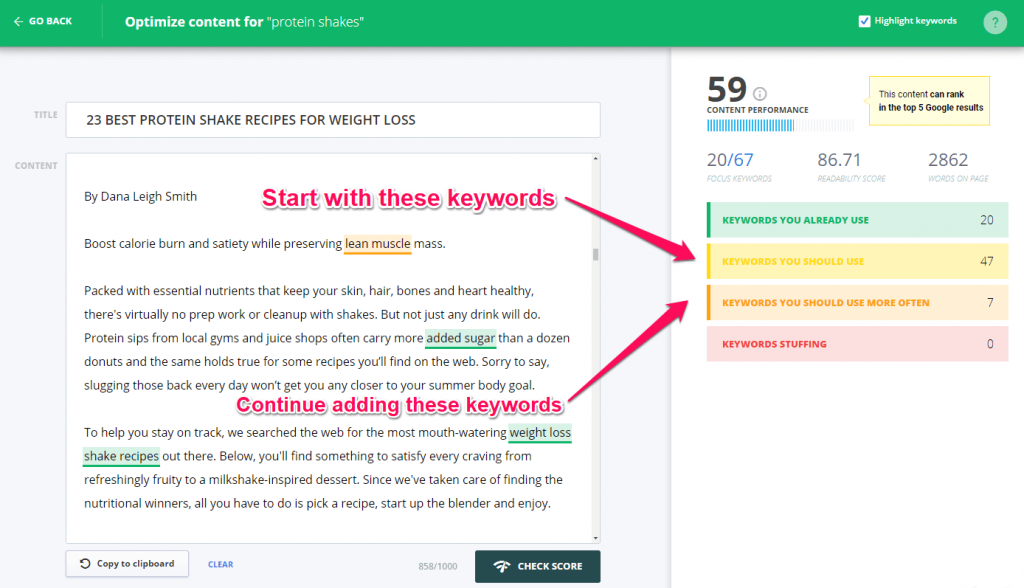
Start with “keywords you should use” and focus on the ones that have a bold font and a dot in front of them, then circle around the rest from that list. Once you finished adding all the relevant keywords, move the “keywords you should use more often” by following the same procedure.
Once you finished this step, you can promote your blog post and keep track of the outcome.
4. Three Methods to Measure the Effects of Your Article
Measuring the results is a step that can’t be avoided. You should keep track of the keyword you optimized the content to see the evolution.
Method 1: Google Search Console
GSC or Google Webmaster tools is a good support for this. Go to your account » Search Traffic » Search Analytics and track individual pages.

As you can see in the next screenshot, you have data on the number of impressions, average CTR, and average position. Search for your page to see how well is ranking: Pages » Filter Pages and paste the URL.
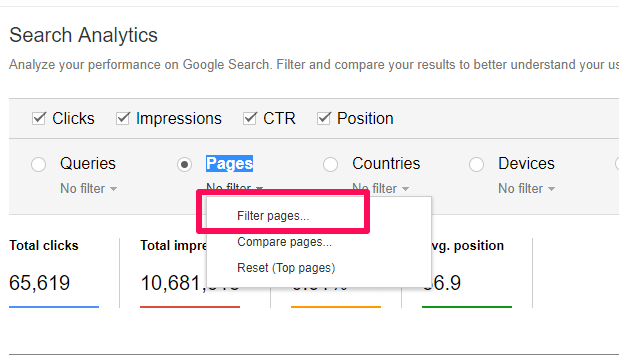
Method 2: Rank Tracking
You can also use the Rank Tracking tool to see the whole list of keywords at once and follow the historical trending line. You have to add the keywords and after that, you’ll have to wait to see how it is evolving day by day.
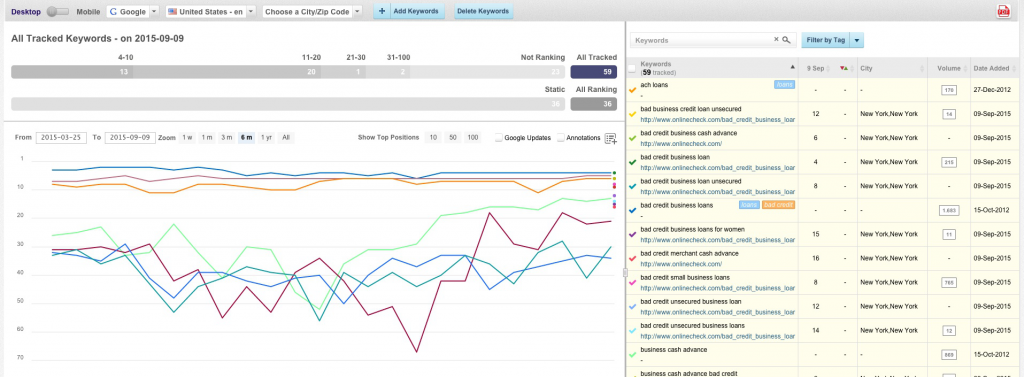
For a massive content optimization, you should look at the search visibility to see if you’re on an ascendant line or not. The search visibility shows you how your websites ranks overall for all the possible keyword combination that you might be or might not be aware of. Below you can see an example:
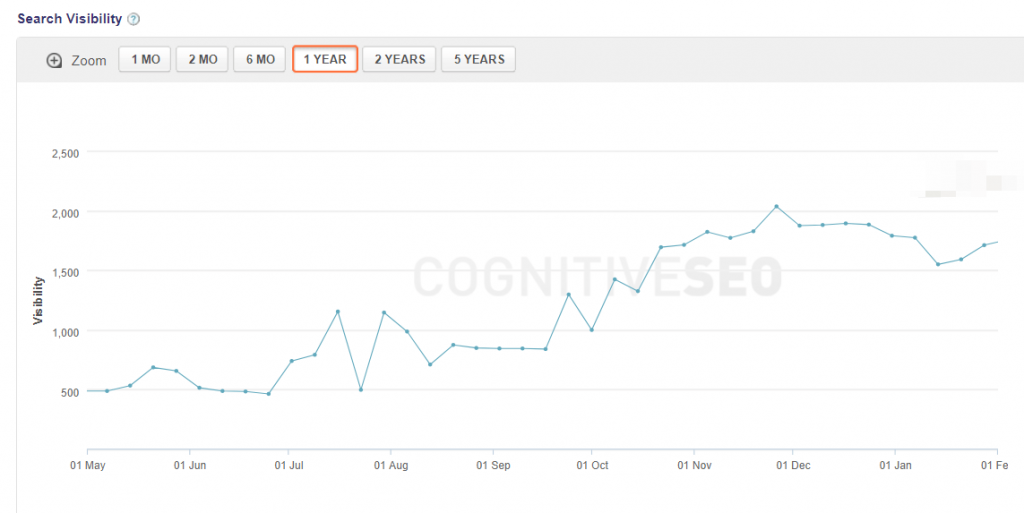
Method 3: Google Analytics
Google Analytics is another provider that can offer qualitative data, most of the times. I’ve conducted an informative guide some time ago on how to improve search engines rankings using Google Analytics data which I recommend you reading it. It is a good starter for understanding your audience: likes, interests, behavior, demographics. You’ll find out how to improve your conversion rates and see which type of content brings more traffic, from what sources and other technical information.
All the data you get will help you have a better content management.
Conclusion
Writing high-quality content isn’t so hard, but it isn’t piece of cake either. It requires knowledge, desire, strategical thinking and tools to ease up the work. If you understand what quality content and relevant content means, then you’re two steps forward.
You need an idea and then craft unique content around it to differentiate yourself from the audience. On-site optimization is the next step. Use the right keyword to create context and highlight the quality of your content. In the end, promote it and track the results.
Analytical data offers valuable insights into your content, audience, and business in general. It can bring a lot of benefits to start mushrooming your inbound marketing strategies and outperform your actual content marketing campaign. All these steps will help you fulfill your goals so best of luck in using them!

 Site Explorer
Site Explorer Keyword tool
Keyword tool Google Algorithm Changes
Google Algorithm Changes

Hi,
What a fantastic post! Full of useful information. I can’t wait to dig deep and start utilizing the resources you have given me.